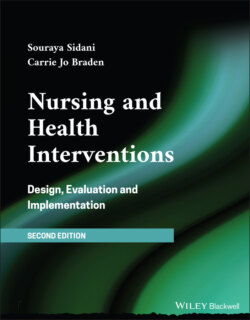Читать книгу Nursing and Health Interventions - Souraya Sidani - Страница 37
2.3.3 Dose
ОглавлениеDose (also called intensity) refers to the level at which the intervention as‐a‐whole (i.e. including all its components) is delivered in order to effectively address the health problem and produce beneficial changes in other outcomes. Similar to the dose of medications, the dose of health interventions is operationalized in four aspects: purity, amount, frequency, and duration.
Purity reflects the concentration of the active ingredients of the intervention; it can be quantified as the ratio of specific to nonspecific elements constituting the intervention. Amount, frequency, and duration reflect exposure to the intervention. Specifically, amount refers to the quantity with which the intervention is given. Quantity is represented by the number of contacts (e.g. individual or group sessions, home visits) planned with the health professional or laypersons responsible for delivering the intervention; or the number of modules (e.g. sections in a paper or electronic booklet) to be completed by clients. Quantity also quantifies the time it takes to complete each contact (e.g. length of a group session) or module (e.g. length of time to read the information presented in each section of the booklet).
Frequency is the number of times the contacts are given or the modules are self‐completed, over a specified period of time such as a week or month. Duration is the total length of time during which the intervention is given. Amount, frequency, and duration are commonly reported to specify the dose of health interventions (Beall et al., 2014). For instance, the dose of the multicomponent intervention for insomnia can be specified as: four group sessions of 60 minutes each and two individual telephone contacts of 20 minutes each, for a total of six contacts (amount). The six contacts are given once a week (frequency), over a six‐week period (duration).
